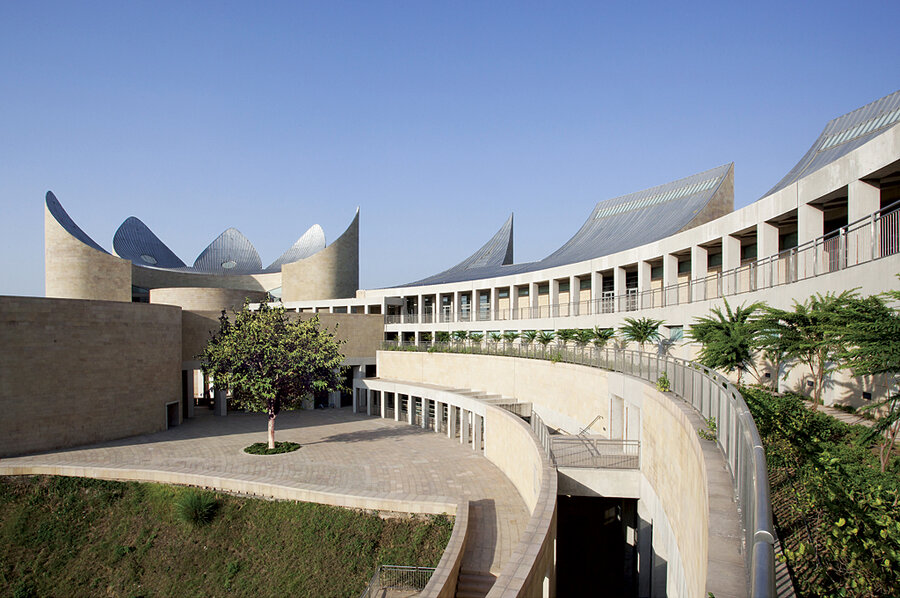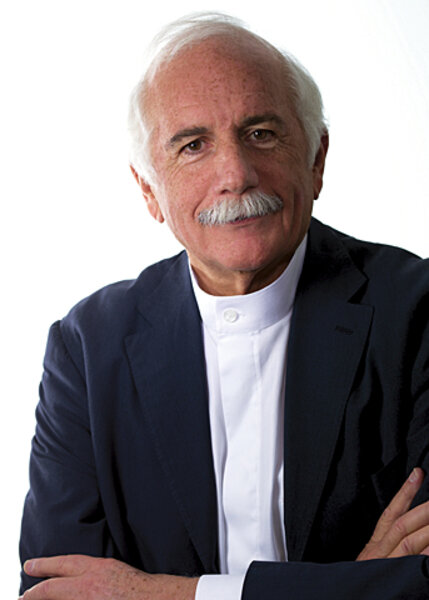Designing for dignity
It may be the Chinese Year of the Rabbit, but 2011 is a bullish year for world-renowned architect Moshe Safdie, whose audacious creations are more jaw-dropping than flop-eared. His stunning resort, Marina Bay Sands, is already inspiring gasps in Singapore, while the Kauffman Center for the Performing Arts in Kansas City, Mo., and the United States Institute of Peace headquarters in Washington, D.C., are slated to open in September. A huge, multipavilioned Sikh museum, the Khalsa Heritage Center, debuts this fall in Punjab, India, and Crystal Bridges Museum of American Art opens its doors in Bentonville, Ark., Nov. 11.
Ever since his master's thesis was realized as Habitat 67 – a pioneering model of humane urban housing – at the Montreal World's Fair (officially known as Expo 67), Mr. Safdie has been at the forefront of innovative design. With 75 major buildings and master plans to his credit during a 44-year career, he's still shaping our habitats in exploding metropolises like Beijing, Mumbai, and Dubai, United Arab Emirates. The year 2011 "is a peak of sorts," Safdie admits, saying he's "superexcited at an amazing confluence of things" – projects opening all over the world, some of which took 10 to 12 years' gestation.
Homage is also pouring in. The exhibition "Global Citizen: The Architecture of Moshe Safdie" was a hit at the National Gallery of Canada earlier this year in Ottawa. (It opens at the Skirball Cultural Center in Los Angeles in 2012 and later at Crystal Bridges.) Donald Albrecht, curator of architecture and design at the Museum of the City of New York, chose the exhibition's title because, he says, "Safdie is himself a global citizen [holding triple citizenship in Israel, Canada, and the US], and he really has a huge, global practice."
Born in Haifa in 1938 when it was part of Palestine, Safdie witnessed firsthand its transformation into the state of Israel in 1948. He spent summers on a kibbutz at a time of austerity, which "affected me for life," he says. "I grew up in a country where the environment was very social justice oriented," the source of his enduring idealism.
While a student at McGill University in Montreal, Safdie tackled "the biggest unsolved problem: urban housing." As he toured gigantic public projects (monolithic slabs that became incubators for crime and poverty) and suburban developments like Levittown, he saw two extremes: "dehumanization or dispersal." He adds, "I thought there was something in the middle, and I came up with a new building typology that led to Habitat."
His prefabricated units were stacked so that the roof of one apartment was the terrace for its upper neighbor. In contrast to cookie-cutter high-rise towers, the units afford ample views, sunlight, privacy, and a sense of community. They combine amenities of the suburbs with interaction of the city. Today, Habitat is considered a landmark in 20th-century architecture, a monument to modernism's utopian vision.
In Jerusalem, Safdie switched gears, adapting his geometric style to a dynamic dialogue with the historic city. One of the most heartbreakingly moving works of all architecture is Safdie's Children's Memorial at Yad Vashem. Based on the Jewish tradition of lighting candles to honor the dead, the memorial consists of a dark, tomblike space lit by a single candle whose flame is infinitely multiplied by mirrored panels. Pictures of the 1.5 million children killed in the Holocaust line a vestibule while a recording chants victims' names. The ensemble has a shattering emotional impact, yet sparks of light flicker like shards of hope.
Safdie also injected a note of optimism into his Holocaust Museum, also at Yad Vashem. He tunneled a dark passage into a hill to a dimly lit chamber. A path winds past exhibits about the horrors of the Holocaust before emerging to a panoramic, sunlit view over the landscape, where, Safdie says, "there is a sense of renewal and hope."
Sheldon Adelson, chairman and chief executive officer of Las Vegas Sands, admired Yad Vashem so much that he commissioned Safdie to design an "integrated resort" in Singapore. The city-state known for social engineering mandated specific criteria: "an iconic cultural building"; a public, pedestrian path along the waterfront; connection to transportation infrastructure; and creation of a life-enhancing destination. Safdie's design for the massive complex is quickly becoming the visual logo of Singapore. "The eighth wonder of the world," Mr. Adelson calls it.
Among the many linked structures, two stand out dramatically: triplet hotel towers topped by a daringly cantilevered, three-acre SkyPark and the ArtScience Museum that some liken to a lotus, with 10 white fiberglass "petals" reaching toward the light.
Safdie's designs reflect both ethical and aesthetic agendas. One building he hopes will produce a positive effect is the new US Institute of Peace headquarters on the National Mall facing the Lincoln Memorial. Founded by Congress in 1984 as a nonpartisan organization devoted to conflict resolution, the federal agency is not well known outside policy circles, partly because its offices were located far from the power grid.
That changes in September, when the institute's new home can show off its mandate to build global peace. Thanks to a highly visible site, Safdie suggests, "This will actually be a peace symbol." The roofline, sheathed with curvilinear shapes that billow upward like the fluttering wings of a dove, is the most dramatic element. The hovering, white-glass shapes change with the light, opaque during the day and "glowing at night," Safdie says, "like the other monuments."
Pointing with pride to a colossal atrium in the Great Hall, press secretary Allison Sturma says Safdie wanted the soaring space to feel uplifting, like the noble mission of the institute. "We're not hippies flashing a peace sign," she says. "Our staff works on the ground to prevent violent conflict or resolve it – easy to say but hard to do."
Safdie is now fulfilling his lifelong desire to mitigate dehumanizing megascale in a 6 million-square-foot residential complex, Golden Dream Bay in Qinhuangdao, China, a beachfront city east of Beijing. The radically original shape of the clustered towers equips 2,200 condo units with gardens, balconies, natural light, and shared recreational facilities. This "habitat of the future" features 15-story-high "urban windows" – voids that frame vistas instead of blocking views. By offering high quality-of-life dwellings in a congested area, "We're actually cracking the middle-income housing syndrome of big-scale, family housing in a dense, urban setting," Safdie says.
After years of mainly cultural and institutional commissions, Safdie's firm is sought after by private developers who used to consider creativity an impractical frill and shun design architects. The recognition has dawned that visionary design is a major – and extremely profitable – attraction.
What Safdie's diverse projects have in common, he says, "is conceptual engagement with a similar principle: They all belong to their cultural and geographic setting." Resisting the uniformity spurred by globalization, Safdie seeks to interpret the "genius loci" (spirit of place) for each project. Alice Walton, Crystal Bridges's founder, selected Safdie for his sensitivity to the site's rolling hills and Ozark woods. "The design responds very gently to the setting, is respectful of nature, and doesn't seek to dominate the landscape," says executive director Don Bacigalupi.
More than four decades down the road from his early triumph, Safdie is at a crossroads. The challenge, he says, is "to solve the extraordinary problems that face us, like sustainability, congestion, density, megascale, transportation issues, and integration into the urban fabric." If his philosophy influences future urban habitats, styles may change. The foundation of architecture would not be the current "auteur" trend of personal, sculptural styles but concern for the fragility of nature and dignity of human nature.






